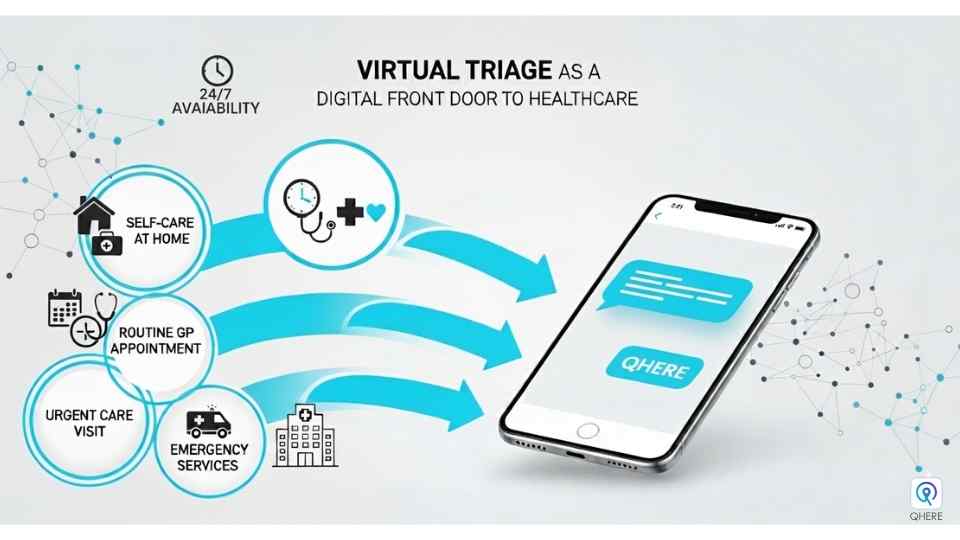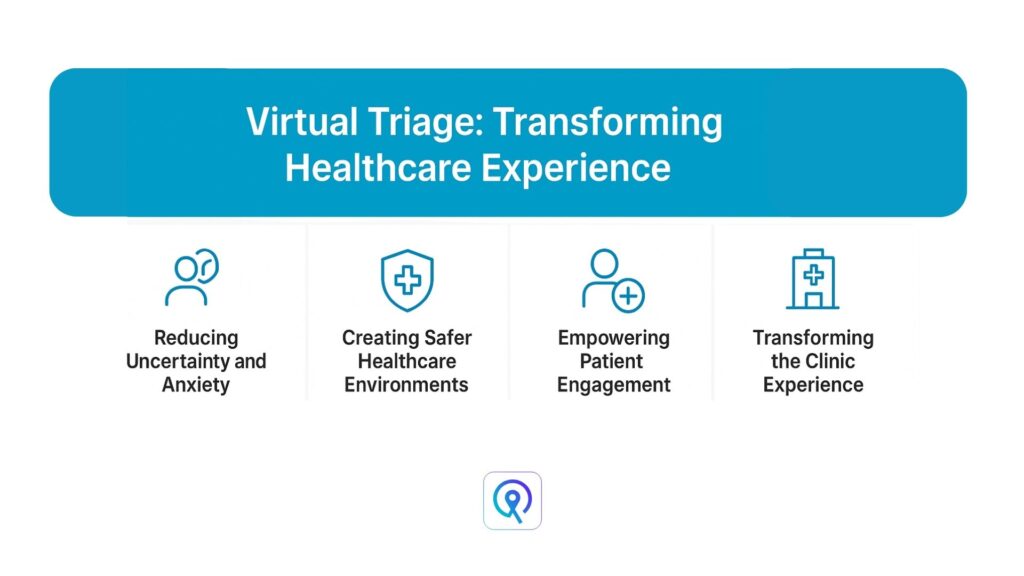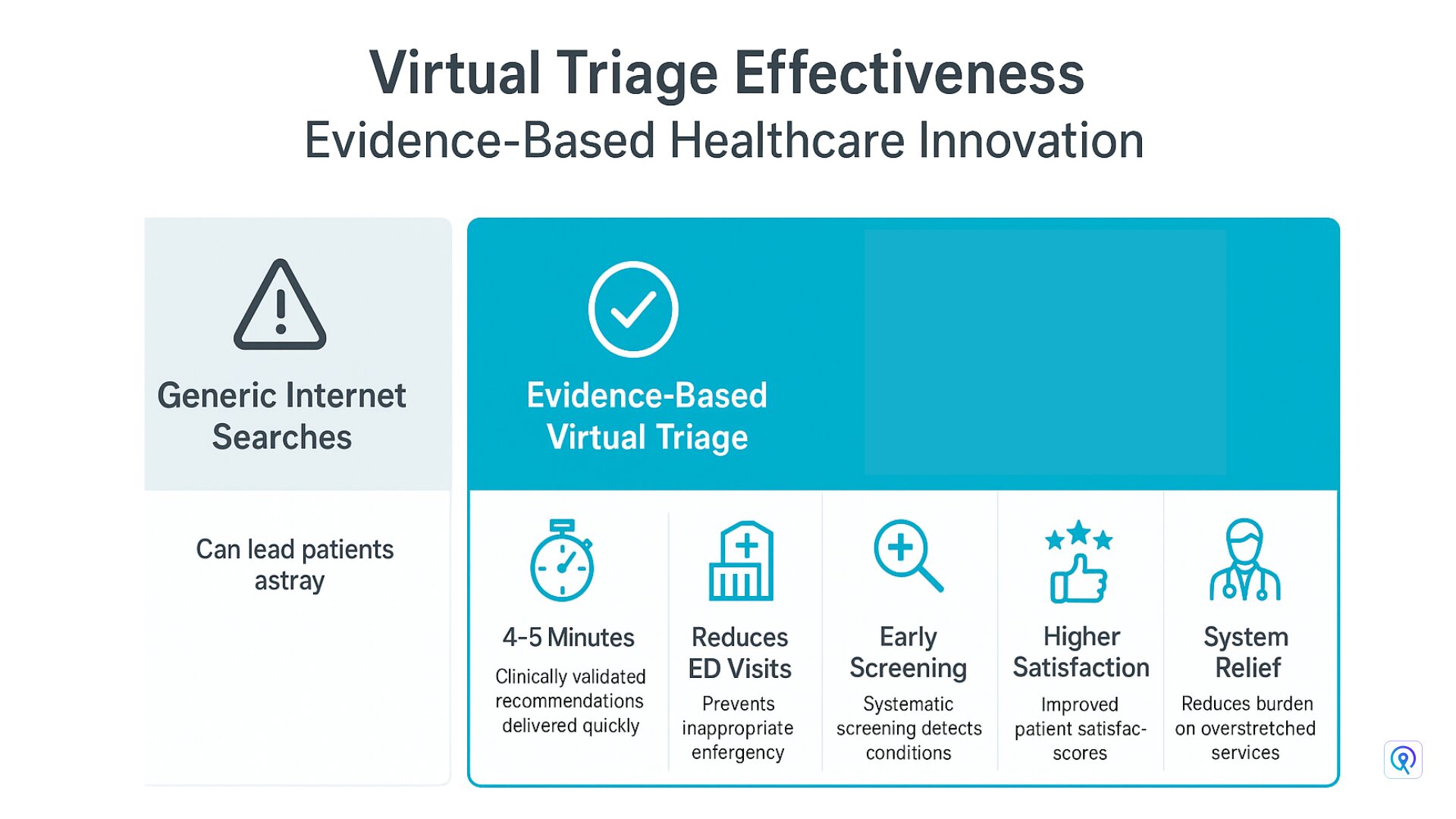Picture this: It’s Sunday evening. Your child has developed a worrying rash, or perhaps you’re experiencing chest discomfort that’s concerning but not quite emergency-level. Do you wait until Monday morning to call your GP? Head to A&E and potentially wait hours for what might be a minor issue? Or frantically search the internet, falling down a rabbit hole of conflicting medical advice?
This scenario plays out millions of times across the UK, where patients struggle to navigate an increasingly complex healthcare landscape. But what if there was a better way? What if technology could help patients make informed decisions about their care while simultaneously helping clinics manage demand more effectively?
Recent research published in Telemedicine Reports reveals how virtual triage technology is revolutionising the patient experience, making healthcare more accessible, personalised, and efficient for everyone involved.
Understanding Virtual Triage

Virtual triage isn’t your typical symptom checker or another health app cluttering your phone. It’s a sophisticated, evidence-based system that acts as a digital front door to healthcare services. Unlike random internet searches that might tell you a headache could be anything from dehydration to something far more serious, virtual triage uses artificial intelligence and medical expertise to provide personalised, clinically appropriate guidance.
The technology works by conducting what researchers call a “preliminary medical interview” – asking targeted questions about symptoms, medical history, and risk factors. Within minutes, it can assess the severity of symptoms and recommend the appropriate level of care: self-care at home, a routine GP appointment, an urgent care visit, or emergency services.
What makes this particularly powerful is its availability. Healthcare doesn’t follow office hours, and neither does virtual triage. Research shows that patients frequently use these tools during evenings, weekends, and nights – precisely when traditional services are least accessible.
The Human Side of Digital Healthcare
You might think that adding technology to healthcare would make it feel less personal, but the opposite is proving true. The research highlights something remarkable: virtual triage can actually make healthcare feel more human-centric and personalised.

Consider how this transforms daily operations:
More Meaningful Consultations: When patients arrive having already completed initial triage, clinicians have detailed information at their fingertips. No more starting from scratch with each patient. Consultations become more focused and productive.
Better Resource Allocation: Virtual triage helps ensure patients are directed to the right level of care from the start. This means GPs aren’t seeing cases that could be managed through self-care, and urgent cases aren’t waiting behind routine appointments.
Extended Reach: Clinics can effectively extend their services beyond traditional hours without additional staffing. Patients can access triage services 24/7, receiving guidance when they need it most.
Improved Staff Satisfaction: When clinical staff spend less time on routine triage and more time on actual patient care, job satisfaction improves. This is crucial in an era where healthcare worker burnout is at crisis levels.
Real-World Impact: What the Evidence Shows

By providing evidence-based guidance, virtual triage helps patients make appropriate care choices, benefiting both the individual and the healthcare system.
Building Trust Through Technology
One of the most significant findings from the research is how virtual triage can actually strengthen the patient-provider relationship. When patients feel their healthcare provider offers modern, accessible, convenient services, trust and loyalty increase.
This trust is built through several key features:
Clinical Credibility: Unlike random internet content, virtual triage systems are developed and validated by medical professionals. Patients receive guidance based on the same clinical protocols doctors use.
Personalisation: The AI adapts its questions based on individual patient responses, creating a conversational, personalised experience despite being automated.
Transparency: Good virtual triage systems explain their reasoning, helping patients understand why certain care levels are recommended.
Integration: When connected to a clinic’s services, virtual triage seamlessly guides patients to appropriate care within their provider network.
Making Every Moment Count
At QHERE, we understand that transforming healthcare isn’t just about implementing new technology – it’s about reimagining the entire patient journey. Our virtual queuing and workforce management solution builds on the principles of virtual triage, creating a seamless experience from first symptom to treatment completion.
We believe that when patients can easily access care guidance, when they can queue remotely rather than in crowded waiting rooms, and when clinics can optimise their operations around actual patient needs, everyone benefits. It’s not about efficiency for efficiency’s sake – it’s about creating space for what truly matters: quality care, meaningful patient-provider interactions, and better health outcomes.
The research is clear: virtual triage and intelligent patient flow management aren’t futuristic concepts – they’re proven solutions available today. The question isn’t whether to embrace these technologies, but how quickly we can implement them to serve our communities better.
Because when it comes to health, time matters. And we’re here to help you make every minute count – for your patients, your staff, and your community.
Interested in learning how QHERE can enhance your clinic’s patient experience through intelligent queuing and workforce management? We’re here to help you create a healthcare experience that’s safer, more dignified, and more satisfying for everyone involved. Let’s explore how we can make your time count.


